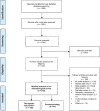A methodological review with meta-epidemiological analysis of preclinical systematic reviews with meta-analyses
- PMID: 36414712
- PMCID: PMC9681751
- DOI: 10.1038/s41598-022-24447-4
A methodological review with meta-epidemiological analysis of preclinical systematic reviews with meta-analyses
Abstract
Systematic reviews and meta-analyses have been proposed as an approach to synthesize the literature and counteract the lack of power of small preclinical studies. We aimed to evaluate (1) the methodology of these reviews, (2) the methodological quality of the studies they included and (3) whether study methodological characteristics affect effect size. We searched MEDLINE to retrieve 212 systematic reviews with meta-analyses of preclinical studies published from January, 2018 to March, 2020. Less than 15% explored the grey literature. Selection, data extraction and risk of bias assessment were performed in duplicate in less than two thirds of reviews. Most of them assessed the methodological quality of included studies and reported the meta-analysis model. The risk of bias of included studies was mostly rated unclear. In meta-epidemiological analysis, none of the study methodological characteristics was associated with effect size. The methodological characteristics of systematic reviews with meta-analyses of recently published preclinical studies seem to have improved as compared with previous assessments, but the methodological quality of included studies remains poor, thus limiting the validity of their results. Our meta-epidemiological analysis did not show any evidence of a potential association between methodological characteristics of included studies and effect size.
© 2022. The Author(s).
Conflict of interest statement
The authors declare no competing interests.
Figures


Similar articles
-
Bias due to selective inclusion and reporting of outcomes and analyses in systematic reviews of randomised trials of healthcare interventions.Cochrane Database Syst Rev. 2014 Oct 1;2014(10):MR000035. doi: 10.1002/14651858.MR000035.pub2. Cochrane Database Syst Rev. 2014. PMID: 25271098 Free PMC article.
-
Do authors of systematic reviews of epidemiological observational studies assess the methodologies of the included primary studies? An empirical examination of methodological tool use in the literature.BMC Med Res Methodol. 2024 Oct 8;24(1):233. doi: 10.1186/s12874-024-02349-5. BMC Med Res Methodol. 2024. PMID: 39379836 Free PMC article.
-
Epidemiology, methodological quality, and reporting characteristics of systematic reviews and meta-analyses on coronavirus disease 2019: A cross-sectional study.Medicine (Baltimore). 2021 Nov 24;100(47):e27950. doi: 10.1097/MD.0000000000027950. Medicine (Baltimore). 2021. PMID: 34964777 Free PMC article.
-
Methological quality of systematic reviews and meta-analyses on acupuncture for stroke: A review of review.Chin J Integr Med. 2017 Nov;23(11):871-877. doi: 10.1007/s11655-017-2764-6. Epub 2017 Sep 13. Chin J Integr Med. 2017. PMID: 28905238 Review.
-
Overadjustment bias in systematic reviews and meta-analyses of socio-economic inequalities in health: a meta-research scoping review.Int J Epidemiol. 2024 Feb 1;53(1):dyad177. doi: 10.1093/ije/dyad177. Int J Epidemiol. 2024. PMID: 38129958 Free PMC article.
References
Publication types
MeSH terms
LinkOut - more resources
Full Text Sources

